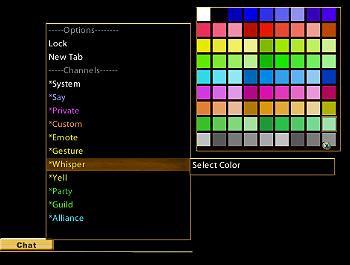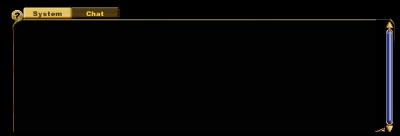Difference between revisions of "KR Chat"
m (→Other: see also) |
|
| (One intermediate revision by one other user not shown) | |
(No difference)
| |
Latest revision as of 21:45, 23 November 2010
This article discusses aspects of the expansion, Ultima Online: Kingdom Reborn.
System and Chat Boxes
When first logging in you will find on your screen a transparent box with two tabs, system and chat.
When right clicking on these tabs an additional menu appears.

To access the FULL list of chat commands (there are lots!) type <enter> /h <enter> you will need to scroll back up in the chat bar to read it as the list is quite long. If your bar won't scroll back, go to the main menu, select 'user settings' and then 'interface' and change the 'chat window fade delay' to 'forever'. It should then let you scroll back.
Hints
- The default for 'system' messages appears to be the System Tab and for 'talking' the Chat tab. This maybe changed as you wish by putting an asterisk * next to any of the menu items in the drop down list. Eg if you wanted to run one tab with all messages, both system and talking, put an asterisk next to eg) 'system' in the above 'chat' tab and the system messages will appear there and not in the system tab.
- You can create 'new tabs' to separate different types of 'chat' (i.e., Guild, Alliance, etc). Once a tab is created rename it by 'right clicking' on the tab name and select what type of chat you wish to have in that tab by putting an * next to the appropriate type.
- You can separate the chat tabs so that all are visible on your screen (If your screen is large enough!)
- You can make the chat box smaller or larger than default size by dragging the bottom right hand corner inwards or downwards.
- Chat Fade Delays : you can stop the chat box window from 'fading' in and out when speaking by going to the Main Menu/User Settings/Interface Tab and altering the default time in the 'Chat Window Fade Delay' and 'Chat Text Fade Delay' You may also select how long you wish on screen chat text to remain over your head by altering the time for 'Overhead Chat Fade Delay' to the desired time.
- To change the color of particular chat types, right click the 'chat' tab, hold your cursor over the type you wish to change, left click on select color and pick a color from the color palette that opens up.
Talking
Talking in game may now be done in two ways:
- Legacy Chat Mode (talk and press enter, type: /p before talking for party chat, type: /g before talking for guild chat, type: /a for alliance chat, type /emote to talk in emotes (asterisks around your speaking) and type: /s to return to normal chat. To set Legacy chat go to the Main Menu/User Settings/Interface and check-mark the legacy chat mode box.
- KR Chat Mode (default) - All talking is done by the ENTER key before and after you say something. This mode lets you use all keys on the keyboard to set macro's without spamming the keystrokes once you have finished and go to speak, so ie, no more fhslslslhglsassaaaa after you are finished fighting and go to talk.
(e.g., <Enter>Hail, tis a fine day!<Enter> This takes a bit of getting used to at first and if you forget you will end up with a lot of pop up boxes as some letter keys are defaulted to open certain other menus. It is just something you will need to get used to.
To talk in party chat it is performed by:
(e.g., <enter>/p Hail, tis a fine day!<enter>)
To talk in guild chat it is performed by:
(e.g., <enter>/g Hail, tis a fine day!<enter>)
To talk in alliance chat it is performed by:
(e.g., <enter>/a Hail, tis a fine day!<enter>)
To talk in emotes it is performed by:
eg <enter>/emote, tis a fine day!<enter> Will appear on screen as *Hail, tis a fine day!*
Basically the difference between the two modes is in Legacy mode you do not need to type <enter> before speaking. Other command are all the same eg to change between guild, party, alliance, local etc.
Custom Channels
KR allows you to create Custom Channels. The person creating the channel has admin rights until they leave the channel when these rights then default to the next longest person in the channel. The commands for Custom Channels are:
- /create <channel name> <password (if required)>- creates a channel. Channel names maybe up to 16 characters in length, however the smaller the better.
- /join <channel name> <password (if required)>- typing this will put you into a created channel
- /c <channel name> - sends a spoken msg to the channel (hence why a short name is best)
- /leave <channel name> - leaves the channel
- /pass <channel name> <password> - changes the password.
- /ban <channel name> <player> - Bans a person from the channel.
- /listplayers <channel name> - to list all persons in the channel.
This feature is handy for groups when they are not guilded or allied, and the party is greater than 10 persons. It provides a way to communicate with larger parties than normal. It also allows 'parties' within 'parties' if you create more than one custom channel with different players in each.
The requirement to type the channel name each time you wish to speak into the channel is a bit 'painful' ie /c thischannel Hello! or /c thatchannel Hello! however, it may serve a purpose as said above.
Other
- To add someone to a party the command is:
<enter>/add (or /add in legacy mode)(which will give you a cursor to target the person) or hold shift and right click on the person and select 'add to party' or click on the person and then right click on the target bar to get the menu.
<enter>/quit (or /quit in legacy mode)(to leave party)You may also leave party by targeting yourself and right clicking on the target box and select leave party.
- To repeat text just spoken (what <ctrl>+Q did in 2d) press <shift>+Page Up.
